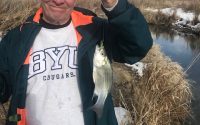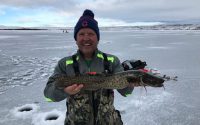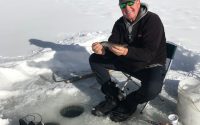Springtime Jerkbaits — Learn By Video
When learning to fish, a wise man once told me “there is no substitute for spending time on the water.” I don’t know how many times during my 25-year writing career I have wished that it would be possible to show my readers exactly what “I” see, and have them understand just how a bait or lure is presented, and why.
Now, thanks to some GoPro cameras and a PowerPole from YoloTech, those days are in the past. Instead of describing how a jerkbait is thrown, retrieved, and “twitched,” all you have to do is watch a video. The words (in my posts) will come to life and you will be able to see the lures, watch the casts, witness the hook sets, and take a look at the fish when they come to shore or into the boat. Just click on a link and you will be whisked away to my YouTube channel and directed to the videos that relate to the current post. Isn’t technology wonderful?
STOCKING KOKANEE SALMON
The first two videos posted were shot at Jordanelle Reservoir on April 3, and 10th of this year. Fishing solo on the third, after watching the stocking of 250,000 kokanee salmon into the Provo River (a few hundred yards upstream from the reservoir), I took the opportunity to target rainbows, cutthroats, and brown trout that will eventually feed on the small (3-inch) kokanees as they enter Jordanelle and get settled. Most of the kokanee will be eaten by the other fish in the reservoir but enough of them should survive to give Jordanelle a chance to become a very fine kokanee fishery. It’s deep, it has distinct channels, and should have plenty of food for the young salmon.
My approach to the day was to start in the actual current of the Provo River as it entered the reservoir. I decided to throw a Lucky Craft Pointer 78 Minnow (jerkbait) in the Ghost Minnow color. That particular color looks like several minnows including trout, bass, and chubs, and even perch (based on its size and shape). The first fish came in 5 feet of water in the very last portion of the Provo River as it smashed into the bank on the south side of the channel. A 20-inch cutthroat chased and caught jerkbait right next to two stumps and a rock outcropping that bordered the channel and a very large sandbar just two feet under the water.
I only caught part of this particular bite due to camera issues (user error) but it turned out to be one of only two cutthroats I caught on both trips.
FISH THE SUNNY SIDE OF THE CHANNEL
Next, I chose to fish the north bank moving with the current and away from the mouth of the river. The north bank receives much more sunlight than the south bank and I figured the fish would appreciate a little warmer water and I happened to be correct.
As I moved into the main body of the lake, I hugged the north shoreline and kept the boat in 20 feet of water, casting all the way to the shore, and expecting to catch fish at about the half-way point during the retrieve. In cold water conditions, even with trout, the fish sense the lures in the water and begin to them, thinking of course that they are food.
After two or three quick jerks straight down as I began to reel, the lure (a suspending jerkbait) would suspend between four and seven feet deep, depending on how hard I jerked and how long I paused the retrieve. When I paused the retrieve and watched the line (I couldn’t yet see the lure even with my polarized sunglasses), I was looking for fish to “flash” by the lure.
POINTS WERE THE KEYS TO FINDING FISH
On most every shoreline are curves and straightaways, but just a the channel of a river swings from side to side, variations in the shoreline creates coves, cuts, and outcroppings, which in turn creates “points,” pieces of the shoreline that stick out and borders coves, cuts, and bays. Wind and water current bump into and move around each point and fish lie in wait in front of, behind, or on the actual point itself, waiting to ambush their prey as it moves with the current.
I found fish on all three areas, behind, in front, and on the other edge of the points.
In all, I fished a little over five hours on the 10th and just 2.5 hours on the 3rd. The fishing wasn’t incredibly quick but I was able to catch eight fish on the third, and along with my buddy Micheal Tuvell, we were able to put 12 fish in the boat. In the springtime, jerkbaits can be exciting lure to use and a great way to wake up the fish.
Please click on the links below to access the videos and then “like” them and be sure to subscribe to the channel.










